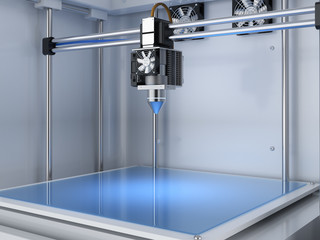Often you may experience 3D prints coming out with rough surfaces and visible layer lines? Probably you’re wondering how to achieve a smooth finish on your prints.
There are several ways to achieve a smooth finish on your 3D prints. In this guide, I will explore 10 ways to do this. Read on;
Sanding and Painting
Sanding and painting are common methods used to achieve a smooth finish on 3D prints. Sanding techniques involve using low to high grit sandpaper to reduce surface roughness, sharp edges, and visible layer lines. By applying sandpaper of different grits, you can achieve optimal results.
Additionally, using filler before sanding can help reduce the time it takes to achieve a smooth finish. Filler application involves applying a thin layer of primer or filler compound to cover irregular patterns and surface defects. This is followed by sanding and priming, which improves the overall surface quality.
When it comes to painting tips for achieving a smooth finish on your 3D prints, there are several things to consider.
Choose your painting style
Brush painting, spray painting, or airbrushing options can be used depending on your preference. It is recommended to sand and prime the print before painting for better results.
Choose right paint products
Choosing the right paint product is also important – Vallejo Metallic Set Model Air Paint provides a metallic look-alike finish while Rust-Oleum Painters Touch 2X Ultra Cover Spray Paint has good adhesion.
Think about the cost
Cost considerations should also be taken into account when deciding whether to use sanding and painting methods for smoothing 3D prints. While these methods are cost-effective compared to other techniques like tumbling or using epoxy resin coatings, they do require labor-intensive work.
Follow safety precautions
It’s important to follow safety precautions when engaging in these processes. Always wear protective equipment such as gloves and goggles when working with potentially hazardous materials like fillers or paints. Ensure proper ventilation when using chemicals like epoxy resin or acetone for vapor smoothing.
Smoothing With Abrasive Methods
Using a vibratory bowl
Tumbling PLA prints with a vibratory bowl can provide smoother results when smoothing 3D printed models. This method involves placing the prints in a vibratory bowl with abrasive media and allowing them to tumble. The constant motion of the bowl and the abrasiveness of the media help to remove layer lines and imperfections, resulting in a smoother surface finish.
Sand blasting
Another option for smoothing is sandblasting. Sandblasting involves using compressed air to propel abrasive particles at high speeds onto the surface of the print. The variables that can affect the outcome include the type and size of abrasive material, pressure, distance from the nozzle, and duration of blasting. It is important to experiment with these variables to achieve desired results.
Metal plating
For those looking for a more advanced approach, metal plating options are available. Metal plating can provide high resistance to heat, chemicals, and weather. The process involves electroless plating where a layer of metal is applied over the 3D printed model through a chemical reaction. Copper, nickel, gold, silver, rhodium, platinum, palladium, and chrome are some options for metal plating.
Melting
Melting can be used as a quick method for smoothing 3D printed models. Heat guns are used to melt the surface of the print which helps blend rough textures and eliminate strings or blobs on FDM parts. However, prolonged exposure to heat may deform the shape of the object so caution should be exercised.
Smoothing With XTC-3D
Using XTC-3D, a low-temperature curing epoxy resin, provides a shiny appearance and can be painted for a smooth and sealed finish on 3D printed models. XTC-3D is an effective option for achieving a glossy finish on your prints. Compared to other smoothing methods such as sanding or abrasive techniques, XTC-3D offers several advantages. It leaves a durable and glossy surface that can be easily painted, allowing you to customize your prints with vibrant colors.
One of the key benefits of using XTC-3D is its ability to seal the print from dirt and liquids, providing added protection. However, there are some cons to consider as well. XTC-3D can be expensive compared to other smoothing methods, adding additional cost to your project. It also adds weight to the print, which may be undesirable in certain applications.
To achieve the best results with XTC-3D, here are some tips:
- Ensure proper ventilation during application due to its fumes; mix the hardener with the resin thoroughly for a complete chemical reaction.
- Apply thin layers of XTC-3D evenly across the print.
- Use a brush or foam applicator for better control.
Common mistakes when using XTC-3D include applying too thick of a layer, which can lead to uneven surfaces or drips. It’s also important to follow the manufacturer’s instructions carefully regarding curing time and temperature.
Overall, when used correctly, XTC-3D can provide a professional-looking finish on your 3D printed models while offering versatility in terms of painting options.
Smoothing With 3D Gloop
When smoothing your 3D printed models, you can try using 3D Gloop, an adhesive that helps with bead adhesion and creates a smoother surface. This method offers several advantages compared to other smoothing methods. However, it is important to be aware of potential hazards and take necessary precautions when using 3D Gloop.
To begin the application process of 3D Gloop, make sure to use protective equipment such as gloves and eye protection to ensure your safety. Simply paint the adhesive onto the surface of your print using a brush or applicator. It is recommended to match the right type of 3D Gloop product with the material you are working with for optimal results.
When comparing 3D Gloop with other smoothing methods like sanding or XTC-3D epoxy resin, one advantage is that there is no need for mixing epoxies with 3D Gloop. Additionally, it is a simpler process compared to applying epoxy resin or sanding multiple layers.
However, it’s important to note that using 3D Gloop can add weight to your print due to the adhesive layer. Furthermore, there may be potential hazards associated with its use such as skin irritation or fumes if not used in a well-ventilated area.
To achieve the desired smoothness with 3D Gloop, consider applying thin coats and allowing each coat to dry before adding another layer. This will help prevent pooling or dripping of the adhesive. Additionally, practice proper technique by ensuring even coverage and avoiding excessive buildup in certain areas.
Smoothing With Polymaker Polysmooth PVB Filament
The Polymaker Polysmooth PVB Filament offers a quick and consistent method for achieving a smoother appearance on your 3D printed models. Using PolySmooth PVB Filament, you can easily enhance the surface finish of your prints.
Here are some key points to consider:
Isopropyl alcohol smoothing
After printing with PolySmooth PVB Filament, you can use isopropyl alcohol to achieve even better results. Simply apply the alcohol onto the printed model using a soft cloth or brush. The alcohol will dissolve the outer layer of the filament, smoothing out any imperfections.
Automated polishing
Another option is to use an automated polisher specifically designed for PolySmooth PVB Filament. These machines provide consistent and efficient polishing, saving you time and effort.
Cost of PVB filament
It’s important to note that PolySmooth PVB Filament is generally more expensive compared to other filaments on the market. Consider this factor when deciding whether it’s worth investing in for your specific project.
Safety precautions for PolySmooth PVB filament
When working with PolySmooth PVB Filament and isopropyl alcohol, it’s essential to take proper safety precautions. Ensure proper ventilation in your workspace, wear gloves to protect your hands, and follow all guidelines provided by the manufacturer.
Subtractive Methods
Trimming, sanding, and filling are effective techniques for achieving a smoother surface on 3D printed models.
Trimming
Trimming involves carefully removing excess material or support structures from the print using tools like knives or files.
Sanding
Sanding is done with various grits of sandpaper to gradually smooth out the surface by reducing visible layer lines and roughness.
Filling
Filling materials such as epoxy putty or filler primer can be used to fill in gaps, seams, or imperfections before sanding to further improve the overall finish.
Sandblasting
Another option for smoothing 3D prints is sandblasting. This process involves blasting fine abrasive particles at high velocity onto the surface of the print to remove roughness and achieve a more polished appearance. Different variables such as particle size, pressure, and distance can be adjusted to achieve desired results.
Priming
After achieving a smoother surface through trimming, sanding, or sandblasting, priming becomes an essential step. Primers provide multiple benefits including filling in small imperfections, creating a uniform base coat for paint adhesion, and enhancing overall durability and appearance.
Electroplating
For those looking for a more advanced finishing method with added durability and aesthetic appeal, metal plating is an option worth considering. It involves applying a layer of metal over the 3D printed model through a chemical process known as electroplating. Options for metal plating include copper, nickel, gold silver rhodium platinum palladium chrome.
Additive Methods
Now that you’ve learned about the subtractive methods for achieving a smooth finish on your 3D prints, let’s explore the additive methods. These techniques focus on enhancing the surface quality through post-processing steps such as melting and annealing, sanding and polishing, applying primer and filling gaps/seams, and painting.
Here are five important additive methods to achieve a smooth finish on your 3D prints:
1. Melting and annealing techniques
Utilizing heat guns, you can quickly melt the surface of your model to blend in lines and rough textures. However, be cautious as prolonged exposure to heat can deform the object. Annealing is another technique used to fix stress and warping in FDM printed models by subjecting them to evenly distributed heat below the material’s melting point.
2. Importance of post-processing
Post-processing plays a crucial role in achieving high-quality results for 3D printed parts. It heavily influences the aesthetics of the final product, so choosing suitable techniques based on printing type, material choice, and desired finish is essential.
3. Sanding and polishing techniques
By using sandpaper with varying grits or polishing compounds/pastes, you can reduce surface roughness, sharp edges, visible layer lines, imperfections, and scratches present on your prints.
4. Applying primer & filling gaps/seams
Applying a thin layer of primer helps cover irregular patterns and surface defects before painting. Using filler primer combined with sanding further improves surface quality by filling gaps or seams.
5. Painting techniques
To cover imperfections and achieve visually appealing finishes on your prints, consider brush painting or spray painting options using suitable paints like Vallejo Metallic Set Model Air Paint or Rust-Oleum Painters Touch 2X Ultra Cover Spray Paint.
Change in Properties
To enhance the properties of your 3D printed models, consider exploring techniques such as heat treatment, chemical treatment, surface treatment, surface texturing, and electroplating.
Melting and annealing
These two methods that can be used to change the properties of your prints. Melting involves using a heat gun to melt the surface of the model, blending rough textures and removing strings and blobs. However, prolonged exposure to heat can deform the shape of the object.
On the other hand, annealing is used to fix stress and warping in FDM printed models by subjecting them to evenly distributed heat below the melting point of the material. Special furnaces and chambers are designed for this process.
Post-processing
In addition to these techniques, post-processing plays a crucial role in achieving a high-quality finish for your prints. Sanding techniques using different grits of sandpaper can reduce surface roughness and visible layer lines. Acetone vapor smoothing is another method that can eliminate layer lines and create a glossy finish by placing the print in a sealed container with acetone fumes.
Nozzle maintenance
Proper nozzle maintenance is important for optimal print results as worn-out or damaged nozzles can negatively impact surface quality. Regularly checking and tightening printer belts also contribute to better surface finishes by reducing vibrations.
Remember that post-processing is key in achieving smooth finishes on your 3D printed models. By incorporating these techniques into your workflow, you will be able to enhance both the aesthetics and functionality of your prints.
Vinyl Wrapping
If you’re looking to enhance the aesthetics of your 3D printed models, consider using vinyl wrapping as a technique. Vinyl wrapping offers several advantages for achieving a smooth finish on your prints.
Here are some key points to keep in mind:
- Vinyl wrapping is frequently used for vehicles, but it can also be applied to 3D printed models. This technique involves draping a vinyl or adhesive foil around the object, which enhances its appearance. In addition it is preferred for objects with simple geometry, as it may be more challenging to wrap complex shapes.
- Vacuum foiling is an automated process that speeds up the vinyl wrapping process and ensures accuracy. It is particularly suitable for objects with simple geometry.
- Metal plating is another option for achieving a smooth finish on 3D printed parts. It offers high resistance to heat, chemicals, and weather. The metal plating process involves applying a layer of metal over the model through electroless plating.
Vacuum Foiling
Vacuum foiling is an automated process that speeds up the wrapping technique and ensures accuracy. It offers several benefits over vinyl wrapping. Firstly, vacuum foiling eliminates the need for manual application, reducing the chances of errors or imperfections in the finish. Additionally, it provides a more professional and seamless look compared to vinyl wrapping.
When considering the cost of vacuum foiling, it is important to factor in the initial investment required for equipment and setup. However, in the long run, vacuum foiling can be more cost-effective due to its efficiency and reduced labor costs.
Vacuum foiling is particularly recommended for complex geometries where vinyl wrapping may not achieve satisfactory results. The automated process allows for better coverage and adherence to intricate shapes, resulting in a flawless finish.
Achieving a professional finish with vacuum foiling is relatively straightforward. The process involves draping a vinyl or adhesive foil around the object while utilizing vacuum pressure to ensure proper adhesion and smoothness. This technique guarantees a consistent and high-quality appearance.
However, it’s worth noting that there are also limitations to vacuum foiling. It may require additional expertise or training to operate the machinery correctly. Moreover, certain materials or surfaces may not be suitable for this method due to compatibility issues.



